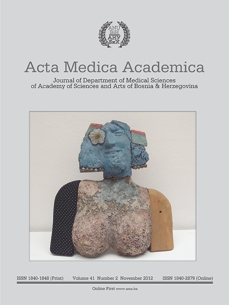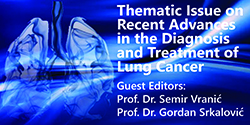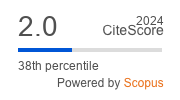Correlation between psychological difficulties in young adulthood and exposure to bullying behavior in childhood and adolescence
Keywords:
Bullying, Psychological adjustment, Young adulthood, Trauma symptoms, Retrospective researchAbstract
Objective. This study investigates the relationship between involvementin bullying in childhood and adolescence and psychological difficultiesin young adulthood. Materials and method. A total of 249college students completed the Retrospective Bullying Questionnaireand Trauma Symptom Checklist. Results. The results showed significantdifferences in psychological adjustment among respondents whowere exposed to bullying compared to respondents who were not exposedto bullying. Those exposed to bullying had significantly higherlevels of anxiety, depression, sleeping problems, and dissociative andtraumatic symptoms compared to those who were not exposed to bullying.Respondents who were exposed to bullying in all three examinedperiods (the period from the first to fourth grade, the period from thefifth to eighth grade and the high school period) had higher scoreson the subscale of dissociative symptoms and sexual trauma symptomscompared to respondents who were exposed through one or twoperiods. Victims abused in all three periods have more symptoms ofanxiety and sleeping problems compared to the subjects exposed tobullying during one examination period. There were no differences inthe level of depressive symptoms and sexual problems regarding theduration of bullying. Also, there were no differences in psychologicaladjustment between respondents who were bullied during one specificperiod. Conclusion. Bullying experiences in childhood and adolescenceare connected with difficulties in psychological adjustment inyoung adulthood.References
Crozier WR, Skliopidou E. Adult recollections of name-calling at school. Educ Psychol. 2002;22(1):113-24.
Rivers I, Duncan N, Besag VE. Bullying: A handbook for educators and parents. Westport: Greenwood/Praeger; 2007.
Rigby K. Consequences of bullying in schools. Can J Psychiatry. 2003;48:583-90.
Holzbauer JJ, Berven NL. Disability harassment: A new term for a long-standing problems. J Couns Dev. 1996;74(5):478-83.
Crick NR, Grotpeter JK. Relational aggression, gender and social psychological adjustment. Child Dev. 1995;66:710-22.
Dake JA, Price JH, Telljohann SK. The nature and extent of bullying at school. J Sch Health. 2003;73(5):173–80.
Forero R, McLellan L, Rissel C, Bauman A. Bullying behavior and psychosocial health among school students in New SouthWales, Australia: cross sectional survey. BMJ. 1999; 319:344–8.
Kumpulainen K, Rasanen E. Children involved in bullying at elementary school age: their psychiatric symptoms and deviance in adolescence. An epidemiological sample. Child Abuse Negl. 2000;24:1567–77.
Nansel TR, Overpeck M, Pilla RS, Ruan WJ, Simons-Morton B, Scheidt P. Bullying behaviors among US youth: prevalence and association with psychosocial adjustment. JAMA. 2001;285:2094–100.
Wolke D, Woods S, Bloomfield L, Karstadt L. Bullying involvement in primary school and common health problems. Arch Dis Child. 2001;85(3):197–201.
Craig WM, Pepler D, Atlas R. Observations of bullying in the playground and in classroom. School Psychol Int. 2000;21:22-36.
Rios-Ellis B, Bellamy L, Shoji J. An examination of specific types of ijime and their prevalence within Japanese schools. School Psychol Int. 2000;21(3):227-41.
Salmivalli C, Lagerspetz K, Bjőrkqvist K, Ősterman K, Kaukianen A. Bullying as a group process: participant roles and their relations to social status within group. Aggressive Behav. 1996;22:1-15.
Radman – Petrušić K. Nasilništvo i strategije suočavanja kod djece osnovnoškolske dobi [diplomski rad]. Zagreb: Odsjek za psihologiju filozofskog fakulteta u Zagrebu; 2005.
Juvonen J, Graham S, Schuster MA. Bullying among young adolescents: the strong, the week, and the troubled. Pediatrics. 2003;112(6 Pt 1):1231-7.
Mazur J, Malkowska A. Bullies and victims among Polish school-aged children. Med Wieku Rozwoj. 2003;7(1 Pt 2):121-34.
Yang SJ, Kim JM, Kim SW, Shin IS, Yoon JS. Bullying and victimization in boys and girls at South Korean primary schools. J Am Acad Child Adolesc Psychiatry. 2006;45(1):69-77.
Ivarsson T, Bronberg AG, Arvidsson T, Gillberg C. Bullying in adolescence: Psychiatric problems in victims and bullies as measured by the Youth Self Report (YSR) and the Depression Self-Rating Scale (DSRS). Nord J Psychiatry. 2005;59:365-73.
Herrenkohl TI, Sousa C, Tajima EA, Herrenkohl RC, Moylan CA. Intersection of child abuse and children’s exposure to domestic violence. Trauma Violence Abus. 2008;9:84-99.
Sternberg KJ, Baradaran LP, Abbot CB, Lamb ME, Guterman E. Type of violence, age, and gender differences in the effects of family violence on children’s behavior problems: A mega-analysis. Dev Rev. 2006;26:89-112.
Wolfe DA, Crooks CV, Lee V, McIntyre-Smith A, Jaffe P. The effects of children’s exposure to domestic violence: A meta-analysis and critique. Clin Child Fam Psych. 2003;6:171-87.
Hawker DSJ, Boulton MJ. Twenty years’ research on peer victimization and psychosocial maladjustment: a meta-analytic review of cross-sectional studies. J Child Psychol Psychiatry. 2000;41:441-55.
Fekkes M, Pijpers FI, Verloove-Vanhorick SP. Bullying behavior and associations with psychosomatic complaints and depression in victims. J Pediatr. 2004;144:17-22.
Kaltiala-Heino R, Rimpela M, Marttunen M, Rimpela A, Rantanen P. Bullying, depression, and suicidal ideation in Finnish adolescents: school survey. BMJ. 1999;319:348-51.
Klomek AB, Marrocco F, Kleinman M, Schonfeld IS, Gould MS. Bullying, depression, and suicidality in adolescents. J Am Acad Child Psych. 2007;46(1):40-9.
van der Wal MF, de Wit CA, Hirasing RA. Psychosocial health among young victims and offenders of direct and indirect bullying. Pediatrics. 2003;111:1312-7.
Kaltialo-Heino R, Rimpela M, Marttunen M, Rimpela A, Ratenen P. Bullying, depression and suicidal ideation in Finnish adolescents: school survey. BMJ. 1999;319:348-50.
Kim YS, Koh YJ, Leventhal B. School bullying and suicidal risk in Korean middle school students. Pediatrics. 2005;115:357-63.
Williams K, Chambers M, Logan S, Robinson D. Association of common health symptoms with bullying in primary school children. BMJ. 1996;313:17-9.
Bond L, Carlin JB, Thomas L, Rubin K, Patton G. Does bullying cause emotional problems? A prospective study of young teenagers. BMJ. 2001;323(7311):480-4.
Kumpulainen K. Psychiatric conditions associated with bullying. Int Journal Adolesc Med Health. 2008;20(2):121-32.
O’Moore AM, Hillery B. What do teachers need to know? In: Elliott M, editor. Bullying: A Practical Guide to Coping in Schools. Harlow: David Fulton; 1991. p. 56-69.
Craig WM. The relationship among bullying, victimization, depression, anxiety, and aggression in elementary school children. Pers Indiv Differ. 1998;24:123-30.
Rivers I, Cowie H. Bullying and homophobia in U.K. schools: A perspective on factors affecting resilience and recovery. JGLED. 2006;3:11-43.
Rivers I, Duncan N, Besag VE. Bullying. Handbooks for educators and parents. Westport, Connecticut, London: Praeger Publisher; 2007.
Sharp S. How much does bullying hurt? The effects of bullying on personal well-being and educational progress of secondary aged students. Educ Child Psychol. 1995;12:81-8.
Due P, Holstein BE, Lynch J, Diderichsen F, Gabhain SN, Scheidt P, et al. Health Behaviour in School-Aged Children Bullying Working Group. Bullying and symptoms among school-aged
children: international comparative cross sectional study in 28 countries. Eur J Public Health. 2005;15(2):128-32.
Rigby K. The relationship between reported health and involvement in bully/victim problems among male and female secondary school students. J Health Psychol. 1998;3(4):465-76.
Storch EA, Ledley DR. Peer victimization and psychosocial adjustment in children: Current knowledge and future directions. Clin Pediatr. 2005;44(1):29-39.
Haavisto A, Sourander A, Multimaki P, Parkkola K, Santalahti P, Helenius H, et al. Factors associated with depressive symptoms among 18-yearold boys: a prospective 10-year follow-up study. J Affect Disord. 2004;2-3:143-54.
Kim YS, Leventhal BL, Koh YJ, Hubbard A, BoyceWT. School bullying and youth violence: causes or consequences of psychopathologic behavior? Arch Gen Psychiatry. 2006;63:1035-41.
Schreier A, Wolke D, Thomas K, Horwood J, Hollis C, Gunnell D, et al. Prospective Study of Peer Victimization in Childhood and Psychotic Symptoms in a Nonclinical Population at Age 12 Years.
Arch Gen Psychiatr. 2009;66:527-36.
Bond L, Carlin JB, Thomas L, Rubin K, Patton G. Does bullying cause emotional problems? A prospective study of young teenagers. Brit Med J. 2001;323:480-84.
Hardt J, Rutter M. Validity of adult retrospective reports of adverse childhood experiences: review of the evidence. J Child Psychology Psyc. 2004;45(2):260-73.
Gilmartin BG. Peer group antecedents of severe love-shyness in males. J Pers. 1987;55:467-89.
Hugh-Jones S, Smith K. Self-reports of short and long term effects of bullying on children who stammer. Brit J Educ Psychol. 1999;69:141-58.
Allison S, Roeger L, Reinfeld-Kirkman N. Does school bullying affect adult health? Population survey of health-related quality of life and past victimization. Aust NZ J Psychiat.2009;43:1163-70.
Olweus D. Victimization by peers: antecedents and long term outcomes. In: Rubin KH, Asendorf JB, editors. Social Withdrawal, Inhibition, and Shyness in Children. Erlbaum: Hillsdale, NJ; 1993.
Roth DA, Coles ME, Heimberg RG. The relationship between memories for childhood teasing and anxiety and depression in adulthood. J Anxiety Disord. 2002;16:149-64.
McCabe RE, Antony M, Summerfeldt L, Liss A, Swinson R. Preliminary examination of the relationship between anxiety disorders in adults and self-reported history of teasing or bullying experiences. CBT. 2003;32:187-93.
Dempsey AG, Stroch EA. Relational victimization: The association between recalled adolescent social experiences and emotional adjustment in early adulthood. Psychol Schools. 2008;45(4):310-22.
Gladstone GL, Parker GB, Malhi, GS. Do bullied children become anxious and depressed adults? A cross-sectional investigation of the correlates of bullying and anxious depression. J Nerv Ment Dis. 2006;194(1-3):201-8.
Ledley DR, Stroch EA, Coles, ME, Heimberg RG, Moser J, Bravata EA. The relationship between childhood teasing and later interpersonal functioning. J Psychopathol Behav. 2006;28:33-40.
Schäfer M, Korn S, Smith PK, Hunter SC, Mora-Merchán J, Singer MM, et al. Lonely in the crowd: Recollections of bullying. Brit J Dev Psychol. 2004;22(3):379-94.
Ronning JA, Sourander A, Kumpulainen K, Tamminen T, Niemela S, Moilanen I, et al. Crossinformant agreement about bullying and victimization among eight year olds: Whose information
best predicts psychiatric caseness 10–15 years later? Soc Psychiatry Psychiatr Epidemiol. 2009;44(1):15-22.
Mora-Merchán JA. Coping strategies: mediators in long-term effects of victims of bullying? Annuary of Clinical and Health Psychology. 2006;2:15-25.
Briere JN, Runtz, MG. The Trauma Symptom Checklist (TSC-33): Early data on a new scale. J Interpers Violence. 1989;4:151-63.
Briere J. Trauma Symptom Checklist for Children (TSCC) Professional Manual. Odessa, FL: Psychological Assessment Resources; 1996.
Chapell MS, Hasselman SL, Kitchin T, Lomon SN, Maclver KW, Sarullo PL. Bullying in elementary school, high school, and college. Adolescence. 2006;41:633-48.
Newman ML, Holden GW, Delville Y. Isolation and the stress of being bullied. J Adolescence. 2005;45:343-57.
Smith PK Madsen K, Moody J. What causes the age decline in reports of being bullies in school? Towards a developmental analysis of risks of being bullied. Educ Res. 1999;41:267-85.
Storch EA, Roth DA, Coles ME, Heimburg RG, Bravata EA, Moser J. The measurement and impact of childhood teasing in a sample of young adults. J Anxiety Disord. 2004;18:681-94.
Jantzer AM, Hoover JH, Narloch R. The relationship between school-aged bullying and trust, shyness, and quality of friendship in young adulthood: A preliminary research note. School Psychol
Int. 2006;27:146-56.
Beck AT. Thinking and depression: II. Theory and therapy. Arch Gen Psychiatry. 1964;10:561-71.
Beck AT. Cognitive therapy and the emotional disorders. New York: International Universities Press; 1976.
Beck AT, Emery G, Greenberg RL. Anxiety disorders and phobias. A cognitive perspective. New York, NY: Basic Books; 1985.
Beck AT, Rush JA, Shaw BF, Emery G. Cognitive therapy for depression. New York: Guliford Press; 1979.
Boulton MJ, Trueman M, Chau C, Whitehand C,
Amataya K. Concurrent and longitudinal links between friendship and peer victimization: Implications for befriending interventions. J Adolesc. 1999;22:461-6.
Espelage DL, Swearer SM. Research on school bullying and victimization: what have we learned and where do we go from here? School Psychol Rev. 2003;32(3):365-83.
Brewin CR. Cognitive change processes in psychotherapy. Psychol Rev. 1989;96:379-94.
Besag V. Bullies and Victims in Schools: A Guide to Understanding and Management. Philadelphia: Open University Press; 1989.
Abrahamson LY, Seligman, Teasdale M. Learned Helplessness in Humans: Critique and Reformulation. J Abnorm Psychol. 1978;87:49-74.
Smokowski PR, Holland K. Bullying in School: Correlates, Consequences, and Intervention Strategies for School Social Workers. Children & Schools. 2005;27(2):101-10.
Rivers I. Recollections of bullying at school and their long-term implications for lesbians, gay men and bisexuals. Crisis. 2004;24:169-75.
Briere J, Runtz M. Symptomatology associated with childhood sexual victimization in a nonclinical adult sample. Child Abuse Neglect. 1988;12:51-9.
Elliott DM, Briere J. Sexual abuse trauma among professional women: Validating the Trauma Symptom Checklist-40 (TSC-40). Child Abuse Neglect. 1992;16:391-8.
Herman JL. Father-daughter incest. Cambridge, MA: Harvard University Press; 1981.
Kochenderfer BJ, Ladd GW. Peer victimization: Cause of consequence of school maladjustment? Child Dev. 1996;67:1305-17.
Ttofi MM, Farrington DP, Lösel F, Loeber R. Do the victims of school bullies tend to become depressed later in life? A systematic review and meta-analysis of longitudinal studies. J of Aggression, Conflict and Peace Research. 2011;3:63-73.
Rigby K, Slee PT. Bullying among Australian school children: reported behaviour and attitudes to victims. J Soc Psychol. 1991;131:615-27.
Ledley D, Stroch E, Coles M, Heimberg R, Moser J, Bravata E. The Relationship between childhood teasing and later interpersonal functioning. J Psychopathol Behav. 2006;28:33-40.
Andreou E. Bully/victim problems and their association with psychological constructs in 8-to 12-year old Greek school-children. Aggressive Behav. 2000;26:49-56.






